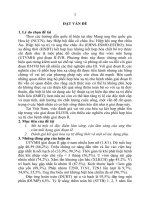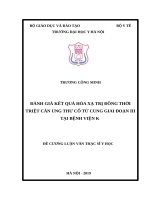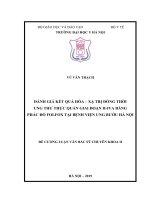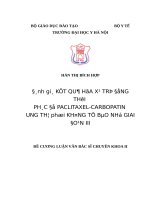Đánh giá kết quả hoá xạ trị đồng thời ung thư phổi tế bào nhỏ giai đoạn khu trú phác đồ cisplatin-etoposide tại Bệnh viện K.Tóm tắt luận án Tiếng Anh
Bạn đang xem bản rút gọn của tài liệu. Xem và tải ngay bản đầy đủ của tài liệu tại đây (575.69 KB, 26 trang )
MINISTRY OF EDUCATION AND TRAINING
MINISTRY OF HEALTH
HANOI MEDICAL UNIVERSITY
HOANG TRONG TUNG
EFFICACY OF CONCURRENT CHEMORADIATION
LIMITTED STAGE SMALL CELL LUNG CANCER WITH
CISPLATIN-ETOPOSIDE REGIMEN
AT K HOSPITAL
Specialty: Oncology
Code: 9720108
SUMMARY OF PhD. THESIS IN MEDICINET
HA NOI - 2022
THE STUDY IS COMPLETED AT
HA NOI MEDICAL UNIVERSITY
Mentor:
Assoc.Prof. Bui Cong Toan
Opponent 1: Assoc.Prof.Pham Cam Phuong
Opponent 2: Assoc.Prof.Nghiem Thi Minh Chau
Opponent 3: Assoc.Prof. Phan Thu Phuong
The thesis will be presented committee of Ha Noi medical
university at o’clock, Date
/
/2022
The thesis could be found in:
1. National Library
2. Library of Hanoi Medical University
1
INTRODUCTION
Lung cancer is a malignancy and the most common cause of cancer
death globally. According to statistics of the International Organization for
Research on Cancer (GLOBOCAN 2020), there are an estimated 2.2
million new cancer cases, accounting for 11.4% of all cancer patients and
1.79 million deaths. , which accounts for 18% of all cancer deaths overall.
In Vietnam, cancer registry program in 2020 shows that lung cancer has a
high morbidity and mortality rate in both sexes.
According to the classification of the World Health Organization
(WHO), lung cancer is divided into two main groups based on
histopathological characteristics: non-small cell lung cancer, accounting for
85-90% and small cell lung cancer. These two histopathological forms are
fundamentally different in terms of treatment modality and prognosis. Smal
cell lung cancer has different characteristics compared to other groups with
high malignancy, poor prognosis, rapid growth, early distant metastasis if
not diagnosed and treated promptly. In clinical practice, SCLC is divided
into 2 stages: the localized stage and the extended-stage, in which the
localized stage accounts for 1/3 of the patients with SCLC at the time of
diagnosis.
In terms of disease treatment, in the past, due to limited technical
issue as well as understanding of the biological nature of the disease, the
treatment of limited-stage small cell lung cancer was usually applied
sequentialy. Nowaday, the principle of multimodal treatment by combining
treatment methods, they are combined at each stage, each time to give best
results. Concurent chemoradiation is a radical treatment method for patients
with limited-stage small cell lung cancer. The regimen has been applied in
many countries such as Japan, Canada, the US, Europe... and has proven
effective in helping to increase the response rate, decrease recurrence rate,
and prolong overal survival. In Vietnam, concurrent chemoradiotherapy
regimens for limiteded-stage SCLC have been applied in the past few years,
but no studies have reported the effectiveness of the regimen. Therefore, we
conducted this study with two objectives:
Objectives:
Primary objective: Describe some characteristics of limited-stage small
cell lung cancer treated with concurent chemoradiation at Hospital K
Secondary objectives: To evaluate efficacy of concurent chemoradiation
with Cisplatin-Etoposide regimen.
2
These new findings of the thesis:
1. Small cell lung cancer is a disease with high malignancy, poor
prognosis, with rapid progression, early distant metastasis if not diagnosed
and treated promptly. When the disease is at a localized stage, the
chemotherapy and radiotherapy regimen at the same time helps to improve
the treatment efficiency and prolong the survival time. However, the
undesirable effects encountered are also higher. That is why it was difficult
to apply before. With the development of more advanced radiotherapy
techniques and new chemotherapy regimens, the control of undesirable
effects has also improved. New regimens have been applied in clinical
practice in our country in recent years. This is the first study in Vietnam to
study the effectiveness of concurrent chemoradiotherapy regimens for
limitted-stage small cell lung cancer.
2. Results from the study showed that:
The response to treatment was high with the overall response rate of
95.3%, of which the complete response reached 54.6%. 40.7% achieved a
partial response in which most had a reduction of more than 60% of tumor
volume compared to baseline. The response was higher in the group of
patients with good condition index PS=0; Age, weight loss, NSE/Pro GRP
levels, radiation dose, or number of cycles of chemotherapy did not differ in
complete response rates.
The progression-free survival was very satisfactory, on average: 14.4 ±
1.3 months. The average overall survival achieved was very encouraging:
23.2 ± 1.6 months. Multivariate analysis of factors affecting progressionfree survival was early stage, response to treatment and full 4 cycles of
chemotherapy. Factors affecting overall survival are stage of disease, lymph
node metastasis, response to treatment and complete 4 cycles of
chemotherapy.
Undesirable effects of concurrent chemoradiotherapy regimens can be
well controlled. The most common undesirable effect on the hematopoietic
system: Grade III and IV leukopenia is 31.1%. Thrombocytopenia grade
III-IV was found in 7.8%. Undesirable effects on the liver and kidneys are
rare, only grade I and II. Side effects related to thoracic radiotherapy such
as pneumonia and esophagitis were only mild, no grade III, IV.
Structure of thesis: This thesis is composed of 128 pages (excluding
appendices and references): Introduction (2 pages), Chapter 1: Overview
(40 pages), Chapter 2: Material and method (13 pages); Chapter 3: Results
(35 page); Chapter 4: Discussion (35 pages); Conclusions (2 pages);
Recommendations (1 page). There are 39 tables, 21 charts and 7 pictures.
3
References: 91 references (Vietnamese and English documents).
Appendices consists of patients list, studying profile, letter.
CHAPTER 1: OVERVIEW
1.1. Epidemiology
Lung cancer is a malignancy and the most common cause of cancer
death globally. According to statistics of the International Organization for
Research on Cancer (GLOBOCAN 2020), there are an estimated 2.2
million new cancer cases, accounting for 11.4% of all cancer patients and
1.79 million deaths. , which accounts for 18% of all cancer deaths overall.
In Vietnam, the results of recording cancer in the population also show that
the incidence of TTP increases gradually over time and the mortality rate
increases gradually over time and especially in both sexes. According to
GLOBOCAN in 2018, Vietnam had 21,865 new cancer patients and 19,559
deaths. After only 2 years, according to GLOBOCAN's report in 2020, the
number of new cases has increased to 26,262 cases and 23,797 deaths from
lung cancer. According to the classification of the World Health
Organization (WHO), cancer is divided into 2 main groups based on
histopathological characteristics: non-small cell lung cancer (NSCLC)
accounting for 85-90% and small cell lung cancer.
1.2. Screening and early diagnosis: people at high risk such as smokers
and over 40 years old
1.3. Definitive diagnosis
1.3.1. Clinical manifestation
- The early stages are often discovered incidentally (about 5-10%). The
advanced stage of HCC usually develops in the large bronchi, grows
rapidly, has high malignancy, and has a variety of clinical manifestations:
cough (may be dry cough or sometimes bloody sputum), chest pain,
shortness of breath, pneumonia. More severe progression: superior vena
cava compression, esophageal compression, nerve compression, pleural
effusion, pericardial effusion, paraneoplastic syndrome...
1.3.2. Work-up: Routine chest X-ray, Computed tomography, Magnetic
resonance imaging, Scanning, PET-CT, Diagnostic ultrasound,
Bronchoscopy, Thoracoscopy and mediastinoscopy, Methods Diagnostic
method for histopathology Sampling by percutaneous thoracic aspiration
biopsy under CT guidance Transbronchial aspiration biopsy, Cytological
diagnosis, Histopathological diagnosis, Tumor markers
1.4. Diagnosis stage
1.4.1. VALSG staging classification
Small cell lung cancer has a very early risk of distant metastasis, even at
4
the time of diagnosis. Up to now, people still use the VALSG (Veterans'
Administration Lung Study Group) stage classification, which divides them
into two main stages: the limitted stage and the extended stage.
• Limitted stage is defined when disease is limited to a field of radiation
therapy, usually assessed to be limited to 1/2 of the thorax and regional
nodes, including mediastinal and ipsilateral supraclavicular nodes. .
• The extended stage is defined as disease beyond the limits of the upper
regions, including pleural effusion, pericardial malignancy, or
hematogenous metastases.
1.4.2 TNM staging classification
Compared with the VALSG classification, the localized stage NSCLC
evaluated at stages I-III can be treated with chemoradiotherapy
simultaneously, excluding cases of T3-T4 because the tumor invades too
wide the irradiation field or has a large irradiation field. satellite tumor
lesions. Invasive stage is evaluated at stage IV or T3-T4 when lesions
cannot be covered in 1 irradiation field.
1.5. Differential diagnosis: NSCLC, neuroendocrine tumor, hamartoma
1.6. Prognostic factors: female, age <70 years, normal LDH quantification,
stage 1
1.7. Treatment
1.7.1. The principles of treatment
Simultaneous chemotherapy and radiotherapy plays the most important
role. Prophylactic brain radiation for controlled cases. Surgery is only of
little value in some cases, after surgery adjuvant chemotherapy is required.
1.7.2. Methods of treatment
1.7.3. Limitted stage: concurrent chemotherapy and radiotherapy is the
standard treatment method, widely applied in countries around the world.
1.8. Research in the world and in Vietnam on concurrent chemo-radio
therapy for limitted-stage small cell lung cancer
1.8.1. International study
Currently, concurrent chemoradiotherapy with Etoposide/Cisplatin (EP)
regimen, in which radiation therapy is carried out concurrently with
chemotherapy in cycles 1 and 2, is the standard regimen in the treatment of
small cell lung cancer. localization phase.
To date, 8 clinical trials and 2 meta-analytical studies have been
performed to determine the timing of chest radiotherapy with chemotherapy
for locally advanced small cell lung cancer. In which, 2 studies with the
most complete design and clearest results include:
5
Phase III clinical trial study was conducted in Japan, randomized to
compare the effectiveness of concurrent chemoradiotherapy and alternate
chemoradiotherapy in the focal stage. In this study, all patients received 45Gy
radiation therapy with 1.5Gy fraction x 2 times/day, chemotherapy using
Etoposide-Cisplatin regimen x 4 cycles. The first group received concurrent
chemoradiotherapy starting from day 1 with EP chemotherapy every 4 weeks.
The second group received rotation therapy, radiation therapy was conducted
after the end of 4 cycles of EP chemotherapy every 3 weeks. The study results
showed that the average survival time of the group receiving chemotherapy and
radiation therapy was higher than that of the group receiving alternating
chemotherapy and radiation, 27 months compared to 20 months.
A second clinical trial was conducted in Canada to compare earlier or later
concurrent chemoradiotherapy being more effective. In this study, radiotherapy
was administered in fractions of 3Gy/day with a total dose of 45Gy for 15 days.
Chemotherapy is carried out early at the 3rd or 15th week. The study results
show that the group receiving chemotherapy and radiation therapy earlier at the
same time has a higher survival result with a median survival of 21 months.
compared with 16 months of late treatment group, the difference is significant
with p=0.008. Two meta-analytical studies demonstrating the role of early
radiotherapy in the first cycle of chemotherapy include: First, the metaanalytical study of Fried et al. (2004) with more than 1500 patients showed that
, radiotherapy early in cycle 1 or 2 of chemotherapy improves survival
compared with radiation therapy later or radiotherapy alternately after the end
of chemotherapy. The 2nd pooled study was a source-based analysis
The accompanying chemotherapy regimens for the localized phase,
chemoradiotherapy and EP chemotherapy are still considered and standard
regimens.
With the EP chemotherapy regimen, the toxicity causing esophagitis,
respiratory toxicity and hematological toxicity was higher. Standard dose and
dose fractionation for concurrent chemotherapy and radiotherapy for localized
small cell lung cancer is still a hot issue and is under extensive research. Small
cell lung cancer is very sensitive to radiation, which suggests that high-dose
radiotherapy in a short time will be more effective and less toxic to healthy
tissues.
The first study was performed from 1989 to 1992 with 417 patients
randomly assigned to receive intermittent high-dose concurrent
chemoradiotherapy compared with standard daily-dose radiotherapy in patients
with locally advanced TCC. In this study, all patients received chemotherapy
with EP x 4 cycles and radiation therapy was started right from the 1st cycle of
chemotherapy. One group received daily radiotherapy at 1.8Gy for a total dose
of 45Gy for 5 weeks. The second group received radiation therapy twice a day,
6
divided dose 1.5Gy total dose 45Gy for 3 weeks. Respondents received
prophylactic brain radiotherapy in both groups. The results showed that the
overall survival time in the group receiving radiation therapy twice a day was
higher than that in the group receiving radiation therapy daily, the 5-year
overall survival rate was 26% compared with 16%. The recurrence rate was
also lower in the twice-daily radiotherapy group, 36% versus 52%. Toxicity
was observed at a higher rate in the twice-daily radiotherapy group with grade
III esophagitis rate of 26% compared with 11% in the once-daily radiotherapy
group. However, late toxicity or irreversible toxicity was similar in both
groups. This study gave a better 5-year overall survival than previous studies.
Therefore, concurrent chemoradiotherapy for localized small-small TTN is also
more applicable
1.8.2. Vietnamese study
The standard regimen for treatment of localized small cell lung cancer
is concurrent chemoradiotherapy, and has been applied in countries around the
world since the early years of the 20th century, but in our country, the treatment
also has many limitations. Therefore, previous studies on the treatment of
localized small cell lung cancer were mainly combined treatment, often with
alternate chemotherapy and radiotherapy, with limited treatment results.
From 2000-2010, at K hospital, there were a few studies on alternating
chemotherapy and radiotherapy with CAV or EP chemotherapy regimens and
thoracic radiotherapy, the response rate obtained was still limited with CAV or
EP chemotherapy regimens. 64.7%. In 2008, Vo Van Xuan, Nguyen Ba Duc
and CS reported the results of treatment with CAV and EP regimens in
combination with radiotherapy for 57 patients, showing that EP regimen has
good survival results at 2 years. than the CAV regimen was 43.5% and 8.82%,
respectively. Dang Thanh Hong et al. (2004) reported the results of treatment of
107 patients with localized cancer with chemotherapy and radiotherapy, showing
that the 2-year survival rate is 15%.
From 2010 to present, thanks to the advancement in radiation therapy, with
3D radiotherapy machine or IMRT. Simultaneously with supportive drugs
during treatment, the basic concurrent chemoradiotherapy regimen has been
applied in clinical practice. However, the reports are only small, clinical case
studies, there are not enough studies to evaluate the results of concurrent
chemotherapy and radiotherapy for small cell lung cancer
CHAPTER 2: MATERIAL AND METHOD
2.1. Patients
The patient with confirmed diagnosis of limitted-stage SCLC was treated
with chemotherapy and radiotherapy concurrently with the Etoposide Cisplatin regimen at K hospital from January 2015 to December 2020.
7
* Selection criteria
- Diagnosis: small cell lung cancer with limitted stage according to
VALSG staging guidelines (the disease is within the limits of being
covered by a radical irradiation field).
- Histopathological results: small cell carcinoma - according to
histopathological classification WHO - 2015.
- Age ≥ 18.
- Be treated concurrent chemoradiation with Etoposide-Cisplatin
regimen. Radiation therapy should be started at the same time as
chemotherapy.
- Good general condition (PS ECOG 0 - 2 according to WHO scale)
- Organ and bone marrow function within limits allowing concurrent
chemotherapy and radiotherapy: Hemoglobin ≥ 9.0 g/dL; quantity of
information report ≥ 1.5 G/L; platelet count ≥ 100 G/L; Serum total
bilirubin ≤ 1.5 times upper limit of normal, AST/ALT ≤ 2.5 times upper
limit of normal; glomerular filtration rate > 40 mL/min according to the
Cockcroft-Gault formula.
- Volunteer to participate in research and have complete records.
* Exclude criteria
- Mixed histopathology of small cell lung cancer and non-small cell lung
cancer
- Patients with malignant pleural effusion or malignant pericardial
effusion
- Patients stage I – T1N0M0
- Patients who have been treated surgically, R2 or N2 cut-outs are
treated for IBD
- The patient received chemotherapy for 3 cycles before receiving
radiation therapy
- Previous history of thoracic and mediastinal radiation therapy
- Symptomatic heart failure at the time of diagnosis or other
cardiovascular diseases: left ventricular dyskinesia, myocardial infarction...
- Have other serious acute and chronic diseases: liver failure, kidney
failure, or allergy to the ingredients of the drug. Or have a history of organ
transplantation.
- Patients with a combination of other cancers except: basal cell skin
cancer, or cervical cancer in situ within the last 5 years.
- Pregnant or lactating women.
- Known allergy or hypersensitivity to any ingredient or excipient of the
drug used in the study regimen
8
2.2. Method
2.2.1. Design of study: Uncontrolled clinical trial
2.2.2. Sample size: Formulation:
n Z (21 / 2)
p.(1 p)
( p. ) 2
Applying the above formula, the calculated sample size is 60.
In this study we have 64 patients.
2.2.3. Procedure
- Clinical information, preclinical tests before treatment.
- Concurrent chemoradiotherapy treatment process: Radiation therapy is
carried out simultaneously with chemotherapy and continued with full dose
treatment in the next cycles of the regimen..
Radiation therapy: Start at the first cycle of chemotherapy and continue
radiation therapy until the full dose. Total radiation dose is 60 Gy, divided dose
2 Gy/day, 5 days/week.
The volume of radiotherapy included lung tumor + ipsilateral hilar nodes
and mediastinum + bilateral supraclavicular nodes.
Chemotherapy: Etoposide – Cisplatin (EP) regimen. Cycle 3 weeks x 4
cycles. The first 2 cycles will be done with radiation therapy.
Cycle 1
Ngày
Cisplatin
Etoposide
Radiation
Cycle 2
Ngày
Cisplatin
Etoposide
Radiation
Cycle 3
Ngày
Cisplatin
Etoposide
Radiation
Cycle 4
Ngày
Cisplatin
Etoposide
Radiation
Week 1
Week 2
Week 3
1 2 3 4 5 6 7 1 2 3 4 5 6 7 1 2 3 4 5 6 7
Week 1
Week 2
Week 3
1 2 3 4 5 6 7 1 2 3 4 5 6 7 1 2 3 4 5 6 7
Week 1
Week 2
Week 3
1 2 3 4 5 6 7 1 2 3 4 5 6 7 1 2 3 4 5 6 7
Week 1
Week 2
Week 3
1 2 3 4 5 6 7 1 2 3 4 5 6 7 1 2 3 4 5 6 7
9
- Radiotherapy procedure:
All patients participating in the study will be treated on a 3D-CRT linear
accelerator with an energy level of 15Mv according to a radiotherapy
procedure that includes the following steps:
Step 1: Record image data – Simulated CT scan
Step 2: Radiotherapy planning system
Step 3: Determine the treatment volumes
Step 4: Total dose and fractionation of radiation therapy
Step 5: Plan your radiotherapy
Step 6: Create shielding blocks
Step 7: Simulate test
Step 8: Radiate and monitor treatment
Step 9: Adjust your radiotherapy plan
2.2.4. Evaluation of treatment results and undesiable effects:
- Assessment of response according to RECIST 1.1: response rate,
related to response with a number of factors.
- Non-progressive survival time, total survival time.
- Univariate and multivariate analysis to find out related factors affecting
survival.
- Some undesirable effects according to NCI's toxicity assessment
criteria version 4.0
2.3. Data analysis
The information was collected through medical record
- Data were input on a database and analyzed by software SPSS, v 16.0
- Using χ2, test – student, log rank to evaluate differences between the
groups.
- P - values of less than 0.05 were considered significant.
Survival time using Kaplan-Meier method. Univariate analysis: Use the
Log-rank test to compare survival curves between groups. Multivariate
analysis: Using Cox regression model with 95% confidence level (p =
0.05).- Study results are displayed in figures, charts, percentage (%),
medium ± standard deviation.
10
CHAPTER 3: RESULT
3.1. CLINICAL CHARACTERISTICS
Table 3.1: Patient characteristics
Characteristics
Age
Giới
Smoking
history
n
1
10
25
26
2
61
3
8
56
< 40
41 - 50
51 – 60
61 – 70
> 70
Male
Female
No
Yes
%
1,6
15,6
39,1
40,6
3,1
95,3
4,7
12,5
87,5
Comment: Under 40 years old is rare (1.6%), male is seen mainly with 95.3%
of cases, the proportion of patients with a history of smoking is high (87.5%).
Table 3.2: Clinical symptoms
Clinical symptoms
Respiratory symptoms
Symptoms and
syndromes due to
compression and invasion
in the thoracic cavity
Systemic symptoms
n=64
%
Cough
Dyspne
Blood cough
Chest pain
37
2
1
19
57,8
3,1
1,6
29,7
Hoarseness
2
3,1
Fatigue
anorexia
weight loss
25
26
22
0
35
29
42
22
39,1
40,6
34,4
0,0
56,3
43,7
65,6
34,4
Paraneoplastic syndrome
Performance status
Ưeight loss
ECOG = 0
ECOG = 1
weight loss under 5%
weight loss over 5%
Comment: Dry cough is the most common symptom, accounting for 57.8%.
Other common non-specific systemic symptoms were fatigue (39.1%),
anorexia (40.6%) and weight loss 34.4%.
In this study, we did not encounter any case of paraneoplastic syndrome.
Performance status (PS) ECOG = 0 accounted for 56.3% and ECOG = 1
11
accounted for 43.7%. 34.4% of patients had weight loss over 5% before
treatment
Table 3.3: Work-up
Chest CT scan (n=64)
n
%
< 5cm
31
48,4
5-7 cm
24
37,5
Tumor size
> 7cm
9
14,1
Invading the
Yes
44
68,9
surrounding
20
31,1
No
organization
Bronchoscopy (n=64)
n
%
Convexity with superficial
99
87,6
ulceration
Image
Tumor ulcers
14
12,4
Infiltration
0
0
Tumor Markers
n
%
Normal
28
43,7
NSE
Elevated (>20 ng/ml)
36
56,3
Normal
16
25,0
Pro-GRP
Elevated (>50 ng/ml)
48
75,0
Comment: The average tumor size before treatment was quite large 11.3 ±
2.3 cm, most of which had necrosis in the tumor (85.1%).
Histopathology of rhabdoid cells accounted for the majority (68.6%),
mitotic index was high > 5/50 microfield (51.1%).
Table 3.4: Disease stage
Disease stage
n=64
%
Tumor stage – T
Node stage – N
Disease stage
T1
T2
T3
T4
N1
N2
N3
Giai đoạn II
Giai đoạn IIIA
Giai đoạn IIIB
9
11
37
7
6
45
13
5
36
23
14,1
17,2
57,8
10,9
9,4
70,3
13,8
7,8
56,3
35,9
Comment: Stage III accounts for 92.2%; stage IIIA accounted for the
highest 56.3%. Stage II accounts for only 7.8%.
12
Tumor in stage T3 accounted for the highest rate with 57.8%. Node N2
accounts for a high rate with 70.3%.
3.2. TREATMENT RESULTS
3.2.1. Response to treatment
* Response rate
Table 3.5. Response rate
Response
Completed Response
Partial Response
Stable disease
Progression disease
Total
Số BN (n=64)
35
26
2
1
64
Tỷ lệ (%)
54,6
40,7
3,1
1,6
100
% tumor shinked
Comment: The rate of complete response was 95.3%, in which the
complete response reached 35/64 patients, accounting for 54.6%. Partial
response rate 40.7%.
100
90
80
70
60
50
40
30
20
10
0
-10
-20
-30
-40
-50
-60
-70
-80
-90
-100
Progressed disease
Stable disease
Partial reponse
Completed response
Figure 3.1. The extent of tumor size reduction compared to before
treatment
13
* Relating response to a number of factors
Table 3.6. Relating response to a number of factors
< 50
≥ 50
Yes
Completed
response
5 (45,5)
30 (56,6)
12 (54,5)
No
24(57,1)
Factos
Age
Weight
loss more
than 5%
PS = 0
PS = 1
Elevated
NSE
Normal
60Gy
Radiatin
dose
< 60 Gy
4 cycle
No.chem
otherapy
< 4 cycle
Total
PS
22 (61,1)
13 (46,4)
18 (50)
17 (60,7)
32 (57,1)
3 (37,5)
31 (53,4)
4 (66,7)
35 (54,7)
Non-completed
Total
P
response
6 (55,5)
11 (100%)
> 0,05
23 (43,4)
53 (100%)
10 (45,5)
22 (100%)
> 0,05
18 (42,9)
42 (100%)
14 (30,9)
15 (53,6)
18 (50)
11 (39,3)
24 (42,9)
5 (62,5)
27 (46,6)
2 (33,3)
29 (45,3)
36 (100%)
< 0,05
28 (100%)
36 (100%)
> 0,05
28 (100%)
56 (100%)
> 0,05
8 (100%)
58 (100%)
> 0,05
6 (100%)
64 (100%)
Comment: The group of patients with PS = 0 had a higher complete
response rate than the group of patients with PS = 1. The difference was
statistically significant with p<0.05. Other factors: age, weight loss, NSE
concentration, radiation dose or number of chemotherapy cycles did not
have any difference in the rate of complete response.
3.2.2. Survival
Progression free survival (PFS)
Figure 3.2. Progression free survival
14
Table 3.7. Progression free survival
Progression free survival (PFS)
Mean
(month)
14,4 ± 1,3
6 month
12 month
18 month
68,6
46,2
22,0
24 month
18,1
Comment: mean of progression free survival was 14,4 ± 1,3 month
Progression free survival according to several factors
Table 3.8. Multivariate analysis of factors related to PFS
Factors
Age
Performance
status
Stage
N stage
Response to
treatment
Radiatin dose
No.chemotherapy
≤ 50
> 50
PS = 0
PS = 1
Stage II
Stage IIIA
Stage IIIB
N1-2
N3
Completed response
Non-completed
response
≥ 60 Gy
< 60 Gy
4 cycle
< 4 cycle
Harard
ratio
(HR)
1
1,354
1
1,215
1
1,665
2,522
1
1,219
1
1,925
1
1,378
1
1,592
Confidence
interval
(95% CI)
0,547 – 1,933
0,854 – 1,413
1,060 – 2,614
1,675 – 3,798
0,852 – 1,860
1,311 – 2,826
0,925 – 1,852
1,110 – 1,915
p
0,486
0,711
0,001
0,071
0,001
0,064
0,026
Comment: Disease stage, response to treatment and full 4 cycles of
chemotherapy are independent prognostic factors affecting the patient's
ASD in multivariable analysis (p<0.05).
Overal survival (OS)
15
Figure 3.3. Overal survival
Table 3.9. Overal survival
OS mean
Overal survival
23,2 ± 1,6
12 month
78,3
Rate of OS (%)
24 month
36 month
45,6
21,1
Comment: The mean overall survival was 23.2 ± 1.6 months
Overal survival according to several factors
Table 3.10. Multivariate analysis of factors related to OS
Factors
Age
Performance
status
Stage
N stage
≤ 50
> 50
PS = 0
PS = 1
Stage II
Stage IIIA
Stage IIIB
N1-2
N3
Harard
ratio
(HR)
1
1,144
1
1,725
1
1,857
2,972
1
2,171
Confidence
interval
(95% CI)
0,905 - 1,399
0,961 - 3,095
p
0,511
0,068
1,110 – 3,107
2,405 - 6,562
0,001
1,233 – 3,823
0,007
16
Completed response
1
0,018
Non-completed response 2,086 1,3345 – 3,236
≥ 60 Gy
1
Radiatin dose
0,844
< 60 Gy
1,054 0,625 – 1,777
4 cycle
1
No.chemotherapy
0,04
< 4 cycle
1,709 1,510 – 2,985
Comment: Disease stage, degree of lymph node metastasis, response to
treatment and complete 4 cycles of chemotherapy are independent
prognostic factors affecting patient's TB disease in multivariable analysis
(p<0.05).
3.2.3. Some undesirable effec
Table 3.11. Hematoligical adverse reaction
Response to
treatment
Any
grade
n
%
Leukopenia
58 90,6
Thrombocytopenia 35 54,9
Anemia
19 29,7
Toxic
Grade I
Grade II
n
22
16
10
n
16
14
5
%
34,4
25,0
15,6
Grade
III
n
%
12 18,6
3
4,7
4
6,3
%
25,0
21,9
7,8
Grade
IV
n
%
8 12,5
2
3,1
0
0
Comment: Hematological toxicity of leukopenia is the most common with
the rate of 90.6%; Grade III and IV leukopenia met 31.1%.
Hemoglobin was less common with an incidence of 29.7%, no grade IV
toxicity. Grade III met 6.3%.
Thrombocytopenia was more common with 54.9% of cases, of which grade
3 and 4 met 7.8%. There were 2 patients with grade IV thrombocytopenia,
accounting for 3.1%.
Table 3.12. Undesirable effects on liver and kidneys
Toxic
Elevated
AST/ALT
Elevated ure
Elevated
creatinine
Any grade
Grade I
Grade II
n
6
%
9,4
n
%
n
%
5
7,8
1
1,6
1
1,6
0
0
0
0
1
1,6
0
0
0
0
Grade III
Grade IV
n
0
%
0
n
0
%
0
0
0
0
0
0
0
0
0
Comment: Undesirable effects on the liver and kidneys were uncommon,
increased liver enzymes 9.4%, increased urea 1.6% and increased creatinine
1.6%.
17
Table 3.13. Non-hematoligical adverse reaction
Toxic
Nôn, buồn nôn
Chán ăn
Thần kinh
ngoại vi
Any grade
Grade I
Grade II
Grade III
Grade IV
n
44
%
68,8
n %
36 56,3
n
6
%
9,4
n
2
%
3,1
n
0
%
0
33
51,6
33 51,6
0
0
0
0
0
0
6
9,4
5 7,8
1
1,6
0
0
0
0
Comment:Vomiting, nausea met with the rate of 68.8%; in which vomiting
grade III is 3.1%.
Anorexia was found in 51.6%, only in grade I. Numbness or peripheral
nerve side effects were only seen in 6 cases, accounting for 9.4%. Only
grades I and II are encountered.
3.2.3. Distribution and degree of toxicity
Figure 3.4. Distribution and degree of toxicity
Comment: Leukopenia is the most common (accounting for 90.6%); in
which grade III and IV also met with 31.1%.
Vomiting-nausea, anorexia, dermatitis, pneumonia or esophagitis are
common, mainly side effects in grades I, II. Rarely grade III, IV.
Side effects related to chest radiotherapy such as pneumonia and
esophagitis were only mild, not grade III, IV.
18
CHAPTER 4: DISCUSSION
4.1. Some clinical features
4.1.1. Age, sex, smoking status
In our study, the lowest age was 24 years old and the highest was 76
years old, the mean age was 58.1 ± 8.5 years old. The most common age
group is from 51 to 70 years old, accounting for 79.7% of cases. Men
account for almost absolute with 95.3%. According to Vo Van Xuan
(2002), also with the localized sequential chemotherapy regimen, the mean
age was 57.1. Studies on the number of patients with small cell lung cancer
in the United States, over the 20-year period from 1997-2017, show that the
average age of the disease is 68.6. This may be because the group of
patients in our study was in the localized stage, and received chemotherapy
and radiotherapy at the same time. Males account for an almost absolute
proportion of 61/64 patients; The percentage of women is only 4.7%, the
study of the author Govidan R (2006) in the United States, with the rate of
women getting small cell lung cancer is increasing, from 1973 to 28% to
2002. 50%. The authors suggest that there are many possible reasons for
this result, one of which is the increasing prevalence of female smoking
including passive smoking.
The rate of smoking pipe tobacco in this study was 87.5%. In which,
the smoking rate in men is 91.8% compared to 0% in women. The results of
this study are completely similar to those of other studies on breast cancer
in our country such as Dang Thanh Hong (2005), Vo Van Xuan (2009).
4.1.2. Clinical symptoms
In our study, the most common symptom was a persistent dry cough, this
rate was 57.8%. This result is similar to the results of domestic authors on
localized rectal cancer such as Vo Van Xuan with 76.7%; Dang Thanh Hong
(2005) is 70.2%. Systemic symptoms, or late-stage disease symptoms such as
dyspnea, hoarseness were also less common in our study. Paraneoplastic
symptoms: In our study, there was no case of paraneoplastic syndrome.
4.1.3. Work-up
Chest CT scan: In terms of tumor size, the average size is 4.6 ± 0.7 cm,
the smallest tumor is 2 cm, the largest is 8 cm. Up to 48.4% of tumors are
<5cm in size. In 68.9% of cases with invasion of nearby organs, the rate of
mediastinal lymph node metastasis detected on computed tomography in
19
our patient group was 100%. This result is lower than that of the author
Dang Thanh Hong (2013), because the author's study also includes the
group at the spreading stage.
Tumor markers: The prevalence of NSE/ProGRP was high, accounting
for only 56.3% and 75% of cases. The results of this study are completely
consistent with the characteristics of previous studies on the concentration
of NSE/ProGRP tumor marker, especially when the patient is in the
localized stage.
4.1.4. Disease stage
The results of the disease stage in our study showed that stage III
accounted for 92.2%; stage IIIA accounted for the highest 56.3%. This
further confirms that small cell lung cancer is a malignancy, rapidly
progressive and often presents with systemic rather than local
manifestations.
4.2. Treatment results
4.2.1. Features of the treatment method
Most of the patients were treated with a dose >85%, accounting for
93.8%. A small portion of patients were treated with <85% dose,
accounting for 6.2%. These patients mainly had a dose reduction after the
first infusion with grade IV leukopenia side effects with fever. There were 8
patients who could not receive full dose of 60Gy radiotherapy due to
tolerability of the regimen. 7 patients developed pneumonia and 1 patient
did not respond during treatment.
4.2.2. Response to treatment
Our study surveyed 64 patients receiving chemotherapy and radiotherapy at the
same time: EP regimen and 60Gy thoracic radiotherapy showed that the overall
response rate was very high, 95.3%, of which the response rate was very high.
Complete response was achieved in 35/64 patients, accounting for 54.6%. The
partial response rate was 40.7%. The results of our study show that the complete
response rate is similar to other studies in the world. The first study in Japan that
applied chemotherapy and radiation therapy at the same time as small cell lung
cancer by Takada M and CS (2002) showed that the overall response rate was
96%, but the response rate was 96%. The complete response is only 40%. This can
be explained because the chemotherapy regimen used in our study is the EP
regimen with a 3-week cycle, while some patients in the author's study use the EP 4
20
regimen. week. With the 4-week EP regimen, the dose of Cisplatin used is very
high 100mg/m2 skin, leading to poor tolerability, patients are often delayed during
treatment, so chemotherapy is usually done only 1 cycle combined with
radiotherapy. Our results are similar to the results of Corinne FF and CS (2017) or
the study of Vo Van Xuan (2009). It is clear that concurrent chemoradiotherapy
regimen has a higher response rate than sequential chemotherapy or chemotherapy
alone. Our conclusion is similar to the results of the meta-analysis of 12 phase III
studies of the authors De Ruysscher D (2016).
Table 4.1. Response rates of some studies
Completed
Author
Regimen
n
response
ORR (%)
(%)
Fukuoka M và CS
Chemotherapy - EP
97
21,0
78,0
(1991)
Suntrom và CS
Chemotherapy 214
32,0
76,0
(2002)
EP/CAV
Kubota K và CS
Concurrent chemo129
70,0
93,0
(2014)
radiation IP
Kubota K và CS
Concurrent chemo129
71,0
95,0
(2014)
radiation EP
Corinne F.F và CS Concurrent chemo247
80,3
97,0
(2017)
radiation EP
Võ Văn Xuân CS
Concurrent chemo90
67,8
96,7
(2009)
radiation EP
Concurrent chemoOur study
64
54,6
95,3
radiation EP
The relationship of complete response rate with some factors: analysis of
the relationship between complete response and a number of factors shows that
only the pre-treatment PS factor has an effect on the complete response. The
group of patients with PS = 0 had a higher complete response rate than the
group of patients with PS = 1 (p<0.05). This result is completely similar to the
assessment from previous studies at home and abroad. Research by Takada
(2002) or before that study by Turrisi (1999) on concurrent chemotherapy and
radiation showed that the better the patient's general condition, the higher the
complete response obtained.
21
4.2.3. Survival
* Progression free survival
The results showed that the average progression-free survival time was
14.4 ± 1.3 months. The progression-free survival rate at 12 months was 46.2%
and 18.1% at 24 months.
The results of our study are similar to those of other authors around the
world when also using 3D radiotherapy in combination with EtoposideCisplatin regimen. Takada et al (2002) with progression-free survival of 23.5%.
Or American authors like Work and CS (2003) are 18%. All studies are aimed
at earlier radiation therapy to bring about earlier effects and limit treatment
resistance of small cell lung cancer cells. The CONVERT trial study by FaivreFinn and CS published in the Lancet (2017) showed that the progression-free
survival time in the group receiving 2Gy/day radiation was similar to that in
our study. ,3 months versus 14.4 months. Meanwhile, in the group receiving
radiation therapy twice a day, each time 1.5Gy had a progression-free survival
time of 15.4 months.
* Overal survival
We also recorded a median STTB of 23.2 ± 1.6 months with 78.3% of
patients achieving survival at 1 year and 45.6% of patients achieving STTB at
time 2. year and 21.1% of patients with STTB at 3 years. The development of
treatment methods, chemotherapy and radiotherapy combined with research by
author Vo Van Xuan (2009) showed that the average overall survival time
reached 20-22 months. . With the first study by Japanese author - Fukuoka M
(1991), the average OS was only 11.7 months.
Survival and some related factors
Multivariate analysis of factors that have a good influence on disease
progression-free survival is disease stage, response to treatment, and complete
4 cycles of chemotherapy.
Disease stage, degree of lymph node metastasis, response to treatment and
complete 4 cycles of chemotherapy are independent prognostic factors
affecting patient's TB disease in multivariable analysis (p<0.05).
This statement in our study is similar to many studies of foreign authors
on patients with limited stage small cell lung cancer. This statement in our
study is similar to many studies of foreign authors on patients with limited
stage small cell lung cancer.
4.2.4. Some undesirable effects of regimen
* Some undesirable effects on the hematological system
Undesirable effects on the hematological system causing leukopenia are the
22
most common with the rate of 90.6%; Grade III and IV leukopenia encountered
18.6% and 12.5%, respectively. Hemoglobin was only seen in 29.7%.
Thrombocytopenia was found in 54.9% of cases, common in grades I and II, 1
patient in grade IV only accounted for 7.8%. No patient deaths related to
hematologic toxicity were reported. In general, the toxicity of combined
chemotherapy and radiotherapy on the hematopoietic system can be controlled.
* Some undesirable effects on liver and kidney
The regimen that affects the liver and kidneys is uncommon, increasing
liver enzymes by 9.4%, increasing Urea by 1.6% and increasing Creatinine by
1.6%. Our results are similar to the results of domestic and international studies
on concurrent chemoradiotherapy for small cell lung cancer.
* Some undesirable effects on non-hematological system
Vomiting-nausea, anorexia: vomiting-nausea and anorexia were found at the
rate of 68.8% and 51.6%. It can be seen that this incidence is very high
compared to some studies in the treatment of chemotherapy and radiation for
other diseases.
Peripheral neropathy: This is an undesirable side effect associated with
Cisplatin. The results of this study are similar to those of previous studies on
treatment with cisplatin. This side effect encountered in this study was low,
partly because the dose of Cisplatin was still low, only 60mg/m2da, and the
irradiation area was less affected.
* Some undesirable effects of thoracic radiotherapy
Pneumonia: When receiving chemotherapy and radiation therapy at the
same time, pneumonia is a dangerous complication that, if not detected in time,
can affect the patient's life, especially in the background of patients with central
lung tumors. less ventilation. The results of our study showed that the rate of
pneumonia in all degrees was 48.4%. However, we only recorded pneumonia
grade I, II. There were no cases of pneumonia grade III, IV or pneumonia
leading to death. The results of this study of ours are lower than that of Vo Van
Xuan (2009) with grade III and IV pneumonia of 8.6%.
Esophagitis: Another toxicity that is more common than pneumonia is
inflammation of the lining of the esophagus. In our study, up to 59.4% of
patients had esophagitis with burning sensation behind the sternum. However,
toxicity was only seen at levels I, II, no patients were found in grade III and IV
toxicity.
Radiation dermatitis: In our study, accounted for 50%, but mainly grade I,
most patients only had a faint red or pale rash at the site of radiation therapy,
then appeared peeling of the upper stratum corneum.
23
* Some undesirable effects of PCI
Hair loss: This is a very common symptom. The results of our study show
that 92.2% of cases appear hair loss.
Headache: This was also a common side effect in our patient group. The
incidence was 78.1%. Most patients have mild headaches, dizziness, and do not
affect the patient's normal life.
In summary, the safety assessment showed that the concurrent
chemoradiotherapy regimen for small cell lung cancer, the most common was
leukopenia, of which severe BC grade III-IV accounted for 15.6%. This is also
a side effect of delaying the treatment process. The worrisome side effects of
concomitant chemoradiotherapy, such as esophagitis and pneumonia, are mild
and manageable. Thus, it can be seen that the concurrent chemotherapy and
radiation treatment of small cell lung cancer with localized stage is safe and
applicable in clinical practice to help improve patient outcomes.
CONCLUSION
Study on 64 patients with localized small cell lung cancer receiving
chemotherapy and radiation therapy at K hospital during the period from
January 2015 to December 2020, we drew some results:
1. Clinical characteristics
- Average age 58.1± 8.5 years; common from 51-70 years old (79.7%).
Males account for 95.3%.
- Cough is the symptom with the highest percentage (57.8%); Accidental
medical examination only accounted for 4.7%.
- 100% of patients have good overall health index, ECOG = 0-1
- Tumor characteristics on chest CT: The average tumor size is 4.6 ± 0.7
cm; 100% of patients have mediastinal lymph nodes >10mm on radiographs.
- Stage III accounts for 92.2%; stage IIIA accounted for the highest 56.3%;
Stage II accounts for only 7.8%. Tumor in stage T3 accounted for the highest
rate with 57.8%. Node N2 accounts for a high rate with 70.3%.
2. Treatment results
- The rate of patients using chemical dose 85-100% of standard dose is
93.8%; 90.6% of patients received 4 full chemotherapy cycles; 12.5% of
patients did not receive enough 60Gy of radiation therapy.
Response to treatment
- The rate of complete response was 95.3%, of which complete response
reached 54.6%. 40.7% of patients achieved partial response, of which 16/26
patients had a decrease of more than 60% of tumor volume compared to









